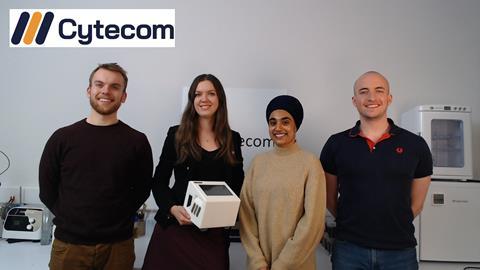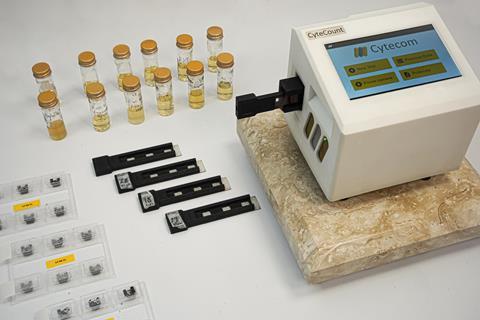New research being presented at the Letters in Applied Microbiology ECS Symposium this May reveals how a new assay could potentially diagnose antimicrobial resistant infections within a matter of hours.

Cytecom Ltd, in tandem with the University of Leicester, have shown that their CyteCount system can be used to differentiate susceptible and resistant bacteria directly in mock blood culture samples, with no additional sample preparation steps.
The technology enables very rapid viability assessment in bacteria by zapping cells with electricity and observing the change in membrane potential.
Noah Tattersall and Inderpreet Kaur of Cytecom Ltd will present the research, ‘Optical electrophysiology for rapid antimicrobial susceptibility testing to enhance bloodstream infections and sepsis management’.
Global deaths
“Bloodstream infections and sepsis cause nearly 20% of global deaths, exacerbated by antimicrobial resistance (AMR). For septic patients, every hour on wrong treatment increases the risk of mortality by 8%,” they say.
“Currently, it takes days for antibiotic susceptibility test results to determine the most appropriate antibiotic to treat a blood-stream infection. This results in broad-spectrum antibiotics being used which can impact the patient’s microbiome as well as fuelling antimicrobial resistance.
“We are aiming to provide clinicians with timely and accurate guidance on optimal antibiotic selection for bloodstream infections within a 2-hour window following a positive blood culture. This will improve patient outcomes by ensuring they are receiving the optimal antibiotic 48-hours earlier than they currently do.
“Earlier, optimal treatment will enable patients to be discharged earlier, reducing the financial and human resources that the health service will be required to provide to treat the individual.”
Zapping the cells
Cytecom has developed innovative tech that enables very rapid viability assessment in bacteria by zapping the cells with electricity and observing the change in membrane potential (using a fluorescent dye), Noah Tattersall explained.

“We wanted to see if our innovative tech could be used to rapidly detect resistant bacteria. We focused our efforts on detecting resistant bacteria in bloodstream infections as this is an unmet need where speed matters most for patients.
“We took horse blood, spiked it with bacteria (E. coli and S. aureus), treated with antibiotics and ran our test. We found that the antibiotic treatment affects bacterial electrophysiology in just a couple of hours and we could clearly distinguish resistant and susceptible bacteria with a zap.”
Surprising find
There was one surprising find, Inderpreet Kaur said: “Assays which test blood culture samples usually require several sample preparation steps before the assay can be used, due to different components of blood interfering with the assay. It was discovered that the CyteCount assay required no additional sample preparation steps when using a blood culture sample compared to testing in culture media.
“This is hugely beneficial as not only does it reduce the time to result but also simplifies the test and reduces the burden on laboratory staff. We expected some interference from other cell types present in blood with our test but this was not the case.
“The CyteCount assay shows huge promise and potential to become a diagnostic device which will enable clinicians to gain valuable information on the most appropriate antibiotic to use to treat a patient with a bloodstream infection. This timely administration of the optimal antibiotic will not only improve patient outcomes, reduce the resource requirements from the health service but also help to reduce the use of broad-spectrum antibiotics which are driving the issue of antimicrobial resistance.”
Proof of concept
Mr Tattersall stressed that these findings are proof of concept data, and more data is needed to validate the technique.
“We need to investigate reducing the exposure time of bacteria to antibiotics prior to testing with the CyteCount to find out how quickly we can detect antibiotic resistance. We also need to correlate the technique to current standard methods and MIC values. We need to validate it so it is safe for patients.”
The research is supported by NIHR FAST, University of Leicester and Cytecom Ltd.
”Leicester BRC played a critical role with the patient involvement in this study, which allowed dialogue between patients and scientists and gave valuable feedback on what to include in the study. This patient involvement has aided in gaining further funding in the form of an NIHR PDA award. Working with NHS as part of our NIHR PDA award we aim to deliver a final product for the patients to save lives,” Noah Tattersall says.
To find out more about the Letters in Applied Microbiology ECS Symposium, visit the event page.
Topics
- Antimicrobial Resistance
- Applied Microbiology International
- blood culture
- bloodstream infections
- Clinical & Diagnostics
- Community
- Cytecom
- CyteCount
- Early Career Research
- Future Technologies
- Inderpreet Kaur
- Infection Prevention & Control
- Innovation News
- Noah Tattersall
- One Health
- Rapid Diagnostics
- sepsis
- UK & Rest of Europe
- University of Leicester







No comments yet